Casualties By Last Name
Losses Chosen & Limitations
Catastropic Losses includes events where more than 8 people were affected by a single event. 8 is typically the maximum number of people on a Halifax or Lancaster bomber for which there were many losses.
This category does not include mid-air collisions or serial-serial ground collision or collateral casualties; those events may be included in future releases.
In the case of the Nerissa no Canadian Airman are shown, but all the casualties shown are men who trained in Canada, and whose last point of departure was Halifax Nova Scotia Canada. Similarly Ferry Aircraft Liberator JT982 has few Canadians but last point of departure was Dorval Airport in Montreal Canada.
Table of Contents
Canso A
11017
1944-11-14
Liberator B-24L / GR Mk. VIII
11121
1945-07-13
 Warrant Officer 2
Warrant Officer 2Argus 2
20727
1965-03-23
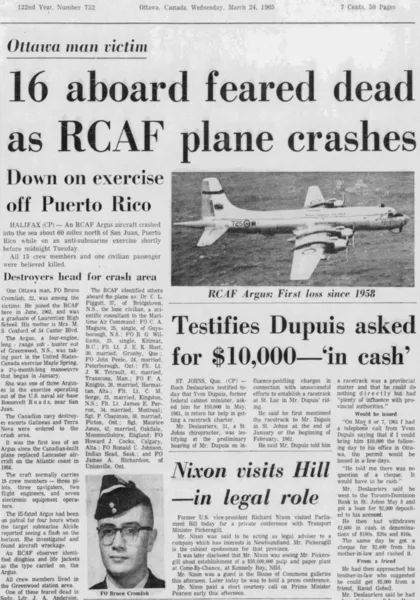
With 405 (MP) Squadron at RCAF Station Greenwood from 29 January 1959. To 2 (M) Operational Training Unit detachment at Greenwood on 3 February 1959. To Fairey Aviation for updates on 24 November 1960. Back at Greenwood from 30 May 1961. To Fairey again for further updates, 8 July 1964 to 6 January 1965. With Argus Conversion Unit at Greenwood in early 1965. With No. 404 Squadron, on detachment to Puerto Rico, when it disappeared during night training mission 60 miles north of Puerto Rico on 23 March 1965. First Argus lost. No trace ever found. 15 fatalities, including two civilian scientists. Disappeared at night, some have theorized aircraft may have dug in a wing tip during a low level turn.
Ventura G.R. Mk. V
2171
1944-07-06
Liberator B-24D / Mk. V
3701
1943-10-20

Ex USAAF B-24D-25-CO serial number 41-24236. General note on the first RCAF B-24Ds (3701 to 3704): Received second hand from USAAF, in very poor condition and without all operational equipment. Mostly used only for training and transportation by RCAF. Initially operated in USAAF camouflage. The designation Mk. V was never officially used by RCAF. These aircraft were generally known as "Brazilian Liberators", in the belief that they had come from a USAAF unit based in Brazil (not confirmed by US records).
Operated by No. 10 (BR) Squadron, RCAF Station Gander, Newfoundland. Went missing on flight from Gander to Mt. Joli, Quebec, on 19 / 20 October 1943. Aircraft was diverted to Dorval because of poor weather at Mt. Joli, wreckage not found until June 1946. 24 fatalities, including most of the crew of Liberator 595, on leave after sinking U-341 a few weeks earlier.
 Warrant Officer 2
Warrant Officer 2 Leading Aircraftman
Leading AircraftmanLiberator Express
41-11708
1943-01-17
Dakota Mk. III
962
1946-09-15
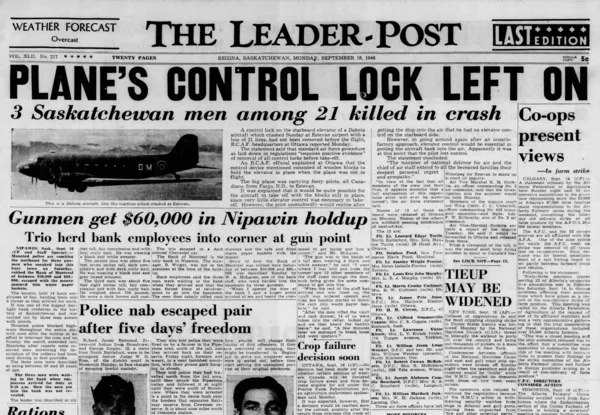
Ex USAAF C-47A-5-DK, serial number 42-92713. With No. 168 (HT) Squadron in 1944, operating between UK and Italy. Based at Gibralter by August 1944. Used by No. 124 (Ferry) Squadron, RCAF Station Rockcliffe, Ontario, to pick up and deliver ferry pilots across Canada. Crashed while delivering ferry pilots to pick up Cornells. Pilot lost control while attempting a go around. Subsequent investigation revealed that starboard elevator lock had not been removed before take off at Minot, ND. This was greatest loss of life in any RCAF accident up to that time. Struck off 25 October 1946.
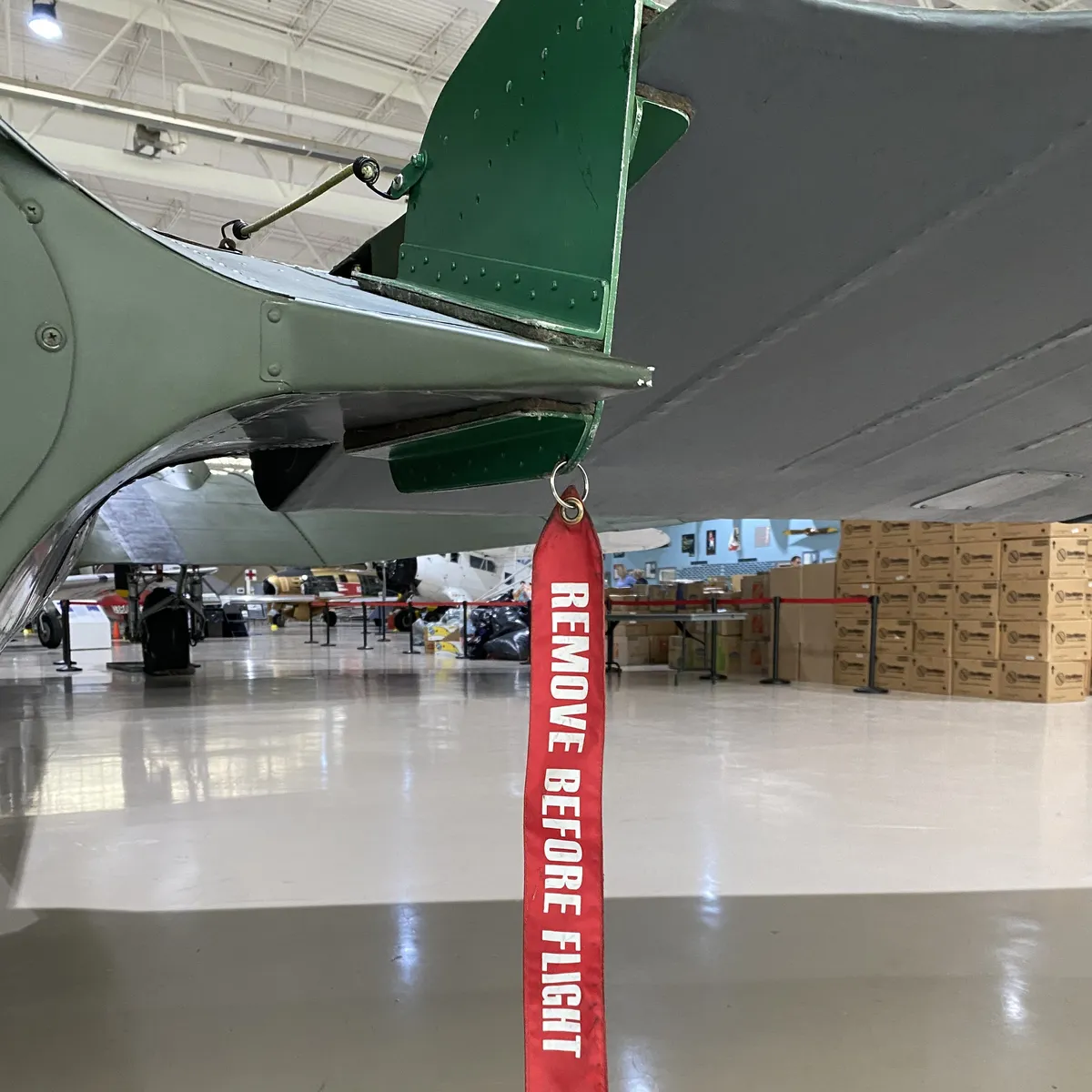
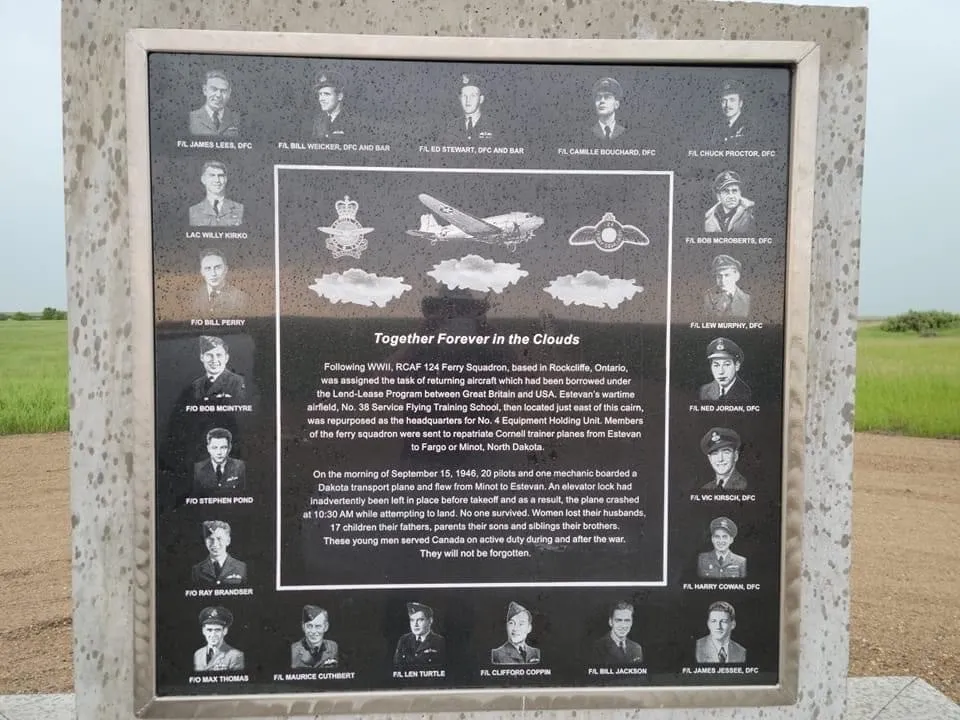
Canso A
9773
1944-05-20
Canso A
9809
1944-04-06
Ventura Mk. I
AE 729
1942-10-26
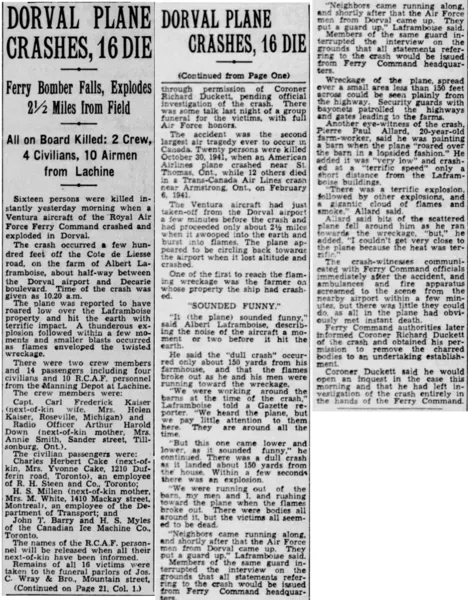
Canada Ferry Command Ventura AE729. Crashed shortly after t/o Dorval. Civilians en route to Goose Bay, Labrador to install equipment at new airport.
The aircraft, carrying 16 people which included 2 Civilian crew members, 10 RCAF airmen and 4 Civilian passengers, was enroute to Goose Bay, Labrador. All 16 perished in the accident. Carl Frederick KAISER, the American civilian pilot, was from Roseville, Michigan, and Arthur Harold DOWN, the Canadian civilian radio operator, was from Tillsonburg, Ontario; the four civilian passengers were to spend the next 6 months installing equipment at the new airport in Goose Bay (they were Charles Herbert 'Bert' Coke (Toronto), H. S. Moden (Montreal), John Joseph Barry (Toronto) and Maurice J. Miles (Toronto). The names of the ten RCAF airmen who perished in the crash were:- Leading Aircraftman Keith Dooks CAMPBELL, Leading Aircraftman Douglas Arthur ABBOTT, Leading Aircraftman John Franklin CARR, Corporal Clifford Thoralf CHRISTOPHERSON, Leading Aircraftman Wesley Bruce DANIELSON, Corporal Michael James KASEY, Leading Aircraftman Bernard Edward MALONE, Leading Aircraftman Vincent Ford PEEBLES, Leading Aircraftman Leslie Vernon SPARKES and Leading Aircraftman Phillip John TENNANT. Hugh Halliday
Liberator C. Mk. II
AL 504
1945-03-27
Liberator C. Mk. II
AL 516
1942-10-31
 Pilot Officer
Pilot OfficerLiberator Mk. II
AL 591
1943-02-09
Liberator
AM 260
1941-08-14
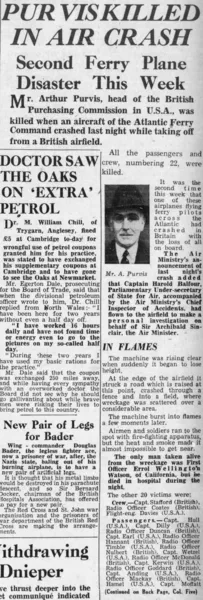
Was US YB-24 s/n 40-698. Crashed and burned on takeoff from Heathfield Airfield, Ayr, Scotland after veering off runway and striking a small building and then an embankment. 22 onboard killed.
RAF Ferry Command, Return Ferry Service Liberator I aircraft #AM 260 crashed and burned when it veered off the runway while taking-off from Heathfield Aerodrome, Ayr, Scotland for a return flight to Ferry Command Headquarters in Dorval QC, killing all 22 civilian aircrew and passengers, including (Pilot) EB Anding (USA), (Pilot) MB Dilley (USA), (Pilot) AC Earl (USA), (Pilot) E Hamel (USA), (Pilot) G Hull (USA), (Pilot) JJ Kerwin (USA), (Pilot) PF Lee Jr (USA), (Pilot) JJ Moffat (Can), (Pilot) Captain RC Stafford (BOAC)(UK), (Pilot) WL Trimble (USA), (Pilot) EW Watson (USA), (Pilot) MJ Wetzel (USA), (Radio Officer) R Coates (Can), (Radio Officer) (Radio Officer) JP Culbert (UK), (Radio Officer) RA Duncan (Can), (Radio Officer) WFJ Goddard (Can), (Radio Officer) DN Hannant (Can), (Radio Officer) JJ MacDonald (Can), (Radio Officer) G McKay (Can),(Radio Officer) A Tamblin (Can), (Flight Engineer) RF Davis (USA) (who was also a USN Reserve Pilot) and civilian passenger AB Purvis (Can), the Head of the British Purchasing Commission (resident of Montreal) (marks www.rafcommands.com).
This was the second serious crash of a Return Ferry Service LB-30 Liberator in 4 days. Please see Anderson, JJ for details and casualty list on crash of Liberator I aircraft #AM 261. Combined, the two aircraft crashes were a significant blow to the ability of Ferry Command to conduct operations.
These crashes may have been the inspiration for the plot device that puts the actors into Ferry Command Hudsons in the Warner Brothers propaganda movie on the RCAF, "Captains of the Clouds" then being filmed in Canada.
 Civilian Pilot (Captain)
Civilian Pilot (Captain)Liberator
AM 261
1941-08-10
Was US YB-24 s/n 40-699. Crashed into mountain range near Arran, Scotland in rain, overcast, and low visibility due to navigation error. 22 killed.Walker
Written off (destroyed) 10.8.41: Crashed in cloud into the hillside of Mullach Buidhe 2,366ft, near Brodick on the Isle of Arran, ca. 41 km WNW of Heathfield (RAF Ayr). The aircraft had take off from Heathfield (Ayr) to fly to Gander in eastern Canada with ferry crews onboard with the intention of those crews ferrying new aircraft back across the Atlantic. Shortly after take off the aircraft entered cloud and flew into Mullach Buidhe near the head of Coire Lan. The flight crews onboard were from Royal Air Force Ferry Command, Air Transport Auxiliary and British Overseas Airways Corperation. All 22 of the crew and passengers perished in the crash making it the worst crash on Arran. This aircraft had been used less than two weeks earlier to fly the Duke of Kent across the Atlantic, the first such time a member of the royal family had crossed the Atlantic by air.
All 5 crew and 17 passengers on board were killed:Ernest Robert Bristow White Captain BOAC Pilot KilledFrancis Delaforce Bradbrooke Captain ATA Co-pilot Killed,James Josiah Anderson Captain RAFFC Passenger Killed, Ralph Bruce Brammer Radio Officer RAFFC Passenger Killed, John Beatty Drake Radio Officer RAFFC Passenger Killed, Daniel Joseph Duggan Captain RAFFC Passenger Killed, Henry Samuel Green Radio Officer BOAC Passenger Killed, George Thomas Harris Captain RAFFC Passenger Killed, Hoyt Ralph Judy Captain RAFFC Passenger Killed, Wilfrid Groves Kennedy Radio Officer RAFFC Passenger Killed, Watt Miller King Captain RAFFC Passenger Killed, George Laing Radio Officer RAFFC Passenger Killed, William Kenneth Marks Radio Officer RAFFC Passenger Killed, Hugh Cameron McIntosh Radio Officer RAFFC Passenger Killed, Albert Alexander Oliver Radio Officer ATA Passenger Killed, George Herburt Powell Radio Officer ATA Passenger Killed, John Evan Price Captain RAFFC Passenger Killed, Herbert David Rees Radio Officer ATA Passenger Killed, Ernest George Reeves Flight Engineer RAFFC Passenger Killed, John James Rouleston First Officer RAFFC Passenger Killed, Harold Clifford Wesley Smith Captain RAFFC Passenger Killed, Jack Wixen Captain RAFFC Passenger Killed
All but one of the crew and passengers were buried on the Isle of Arran, the one who wasn't, Radio Officer Henry Green, was buried at Brookwood Military Cemetery in Surrey.
According to the RAF investigation team, the accident was caused by a navigation error on part of the crew who followed a heading of 295° shortly after take off instead of 012°. It resulted in a deviation of the aircraft which was flying 15 km north of the initial track. The crew was unable to know his real position due to low visibility and the absence of ground visual references.
The Liberator was being operated by the Atlantic Return Ferry Organisation. It took off from Heathfield bound for Canada carrying personnel intended to fly new aircraft back to the UK. The persons on board were mainly from Ferry Command, RAF, with a few from the Air Transport Auxiliary and BOAC. Aviation Safety Network
Hudson Mk. V
AM 602
1942-01-22
Liberator
AM 915
1941-09-01
Ship
BC Star
1943-07-24
The Story of M427 "BC Star"
During the buildup of the war effort on the West Coast many new remote early warning radar units were built and maintained. The RCAF requisitioned tugs and fishing craft that were then attached to the Marine Section to service these otherwise inaccessible stations. These vessels were the "work horses" that plied back and forth on their unscheduled runs moving construction crews, material, and heavy equipment up and down the coast of British Columbia. To help keep these radar unit units' existence and location secret radio silence was enforced on these runs and all information regarding the movement of this type of marine vessel was classified and all communications were coded.
On July 23, 1943, M 427 BC Star was scheduled for one of these runs. She departed Bella Bella with her ten man crew and a cargo of forty-three tons of gravel and cement and five No. 9 CMU personnel assigned to the construction project. They were bound for the new radar site at Cape St. James in the Queen Charlotte Islands. No. 28 (RU) Cape St James had no way of knowing that the supply boat was on its way as they had not yet received the necessary cypher equipment to decode the movement message. Radio silence was enforced on the ship and no one missed her until 3 August when construction crews queried when their supplies were to arrive.
On the 4 August a Stranraer from 9 BR Squadron started the search, on the 5 August, Norseman #2470 was sent from Bella Bella to search area and on 8 August a search was carried out by the M.536 SKEENA MAID. An intense sea and air search covered a wide area during the next several weeks, but only two bodies were recovered and very little wreckage was found. On 3 September an unidentified airman's body was found on Price Island. A tombstone was erected at the Meadow Island Cemetery, Bella Bella, to remember the unknown airman.
Speculation and rumours circulated about the vessel being attacked by a Japanese submarine, and this information was enhanced by crew members aboard another RCAF Marine vessel inbound to Alliford Bay. They reported that they were listening to a Ketchikan Alaska radio station when its program was interrupted by a strange and unidentified transmission "Star out of bread and water. Alliford repeat message. Thank you. Good Afternoon" However, no conclusive evidence ever came to light that explained why the Star went down. Evidently the hull had simply opened up under the weight of her cargo and the M-427 sank so quickly that no life boats were launched and no distress signals were sent.
This supply mission resulted in the largest loss of life in the history of the Marine Branch. The men are commemorated on panel 2 of the Commonwealth Air Forces Ottawa Memorial dedicated to air force personnel lost without trace in Canada, the U.S. and neighbouring lands and seas during the Second World War. One month after the loss, marine craft procedures were revised to ensure prompt reporting of arrivals and departures.
BC Star crew/passenger list 23 July 1943
- R/128864 Cpl Charles Gordon Glover
- R/186865 Leading Aircraftman Harold Fredrick Dakenfold
- R/173910 Leading Aircraftman George Thornton Stead
- R/213870 AC1 Titus Vollhoffer
- R/220368 AC2 Maurice Daniel Onuski
- R/58625 Sergeant Philip Eric Olsen
- R/87823 Leading Aircraftman Clarence James Sherlock
- P/4319 FSergeant Roy Henry Drouillard
- R/146033 Sergeant Jack Douglas Hearfield
- R/220720 AC2 Gilbert Campbell McFadyen
- R/151826 FSergeant William Ernest Mitchell
- R/128695 Sergeant Jonathan Charles Slater
- R/255739 AC2 Arthur Garnet Davies
- R/124630 Sergeant William Murray MacNeill
- R/56918 Cpl Tadeusz Ledwig Polec
The Dedication of the BC Star
July 6th 2013 was a beautifully clear, sunny day. Shearwater Resort's crew boats and others brought in people from the outlying Central Coast villages. A charter aircraft brought forty family members and dignitaries from Vancouver, and a Buffalo from 442 Squadron brought in 888 Wing and 101 Squadron members and their CO Lieutenant-Colonel Todd Sharp, who spoke at the ceremony. In total, nearly 400 people showed up. The dedication of the War Memorial started at 1100 and took two hours. The Warriors pole and the Cenotaph were dedicated first, then a memorial service was held for those who served and those that lost their life serving which included the crews from Canso 9789 and "BC Star". The RCMP and the Colour Party were warm by the time it was over as were the seventeen Chiefs in ceremonial regalia. 101 Squadron's piper and bugler added to the solemnity of the occasion, as did the Chiefs welcoming dance and the defenders dance at the Pole dedication. The CO of 442 Squadron spoke of how the military has evolved and how it is still here to help residents of the Central coast. Two of the sons of the First CO of 9 BR Squadron Commander Squadron Leader Fred Carpenter spoke about their father's experiences. A very fitting tribute to those who served at RCAF Stn Bella Bella and the First Nations members who served in Canada's wars. Then the RCAFA and RCMP members retired for a debrief and some refreshments.
Crash Location 51°53'50.51"³N 129°38'25.65"³W
Cairn Location 52° 8'51.04"³N 128° 5'22.16"³W
https://www.101nisquadron.org/cairn-projects/the-story-of-m427-bc-star/
Liberator B 24
BZ 813
1945-07-04
Liberator B 24
BZ 961
1944-09-14
Liberator B 24
BZ 962
1944-03-01
Sunderland Mk. III
DD 851
1944-11-26
Sunderland Mk. III
DP 178
1944-03-14
Sunderland Mk. III
DP 197
1944-08-15
Halifax B/GR.Mk.II
DT 576
1942-11-29
Lancaster Mk.I/III
EE 113
1943-06-09
Liberator B. Mk. VI
EW 127
1944-10-04
Liberator CV ll
EW 626
1945-03-13
 Warrant Officer Class I
Warrant Officer Class IFlying Fortress III
HB 785
1945-03-21
Liberator C lX
JT 982
1945-07-04
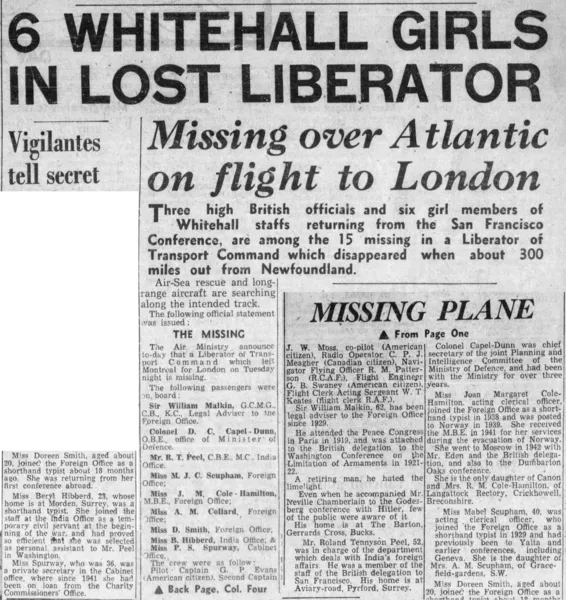
An RAF Ferry Command C.IX Liberator, JT982 of 231 Squadron, was scheduled for a Washington, Dorval, Gander, Keflavik, Prestwick, and Northolt flight itinerary. The aircraft departed RCAF Gander on July 4, 1945 on the leg to Keflavik with a crew of 4 and 11 VIP passengers including several women. While enroute towards Keflavik, the Liberator ditched in the North Atlantic apparently due to the elevator becoming jammed. Although an intensive two week air and sea search was carried out, no trace of the aircraft or crew and passengers were ever found from the missing Liberator.
Lancaster Mk.X/10MP
KB 893
1952-04-25
With 1 Air Navigation School when it crashed at RCAF Station Summerside, PEI on 25 April 1952. Flight Lieutenant W.J.N. Burnett, Flying Officer K.R. Carter, and Flying Officer K.E. Lussier killed.
supplied by Richard Rowntree:
Flown to England to Woodford for tests on 23.2.45; Returned to Canada with #434 Sqdrn. on 8.6.45 as spare in Tiger Force at Dartmouth, N.S.; Converted to Mk.10MP; Post-war KB893 initially served with the Central Flying School at R.C.A.F. Station Trenton, Ontario. It was then transferred to No. 1 Air Navigation School at Summerside, P.E.I. It was carrying out a test flight on the 25th of April, 1952 at Summerside when it bounced on the runway after attempting an overshoot. The pilot retracted the undercarriage while in a very steep climb. The Lanc stalled and crashed. It was subsequently consumed in the ensuing fire. Those killed aboard the Lancaster were as follows: Flight Lieutenant Kenneth Edward Lussier DFC, Flight Lieutenant Walter James Burnett DFC, Flying Officer Kenneth Roland Carter, and Cpl. Joseph Bernard Lachaine SOC 8.5.52
My grandfather was the pilot when this one crashed.
Lancaster MK.X/10MR
KB 995
1953-05-26
Dakota Mk. III
KG 653
1944-09-24
 Leading Aircraftman
Leading AircraftmanLiberator B. Mk. VI
KH 173
1945-01-09
Liberator B 24
KH 210
1945-05-02
Liberator B. Mk. VI
KK 241
1945-06-01
Liberator B 24
KN 768
1945-06-30
Liberator B 24
KN 826
1945-08-02
Hostel
Knights of Columbus
1942-12-12
Knights of Columbus Hostel Fire
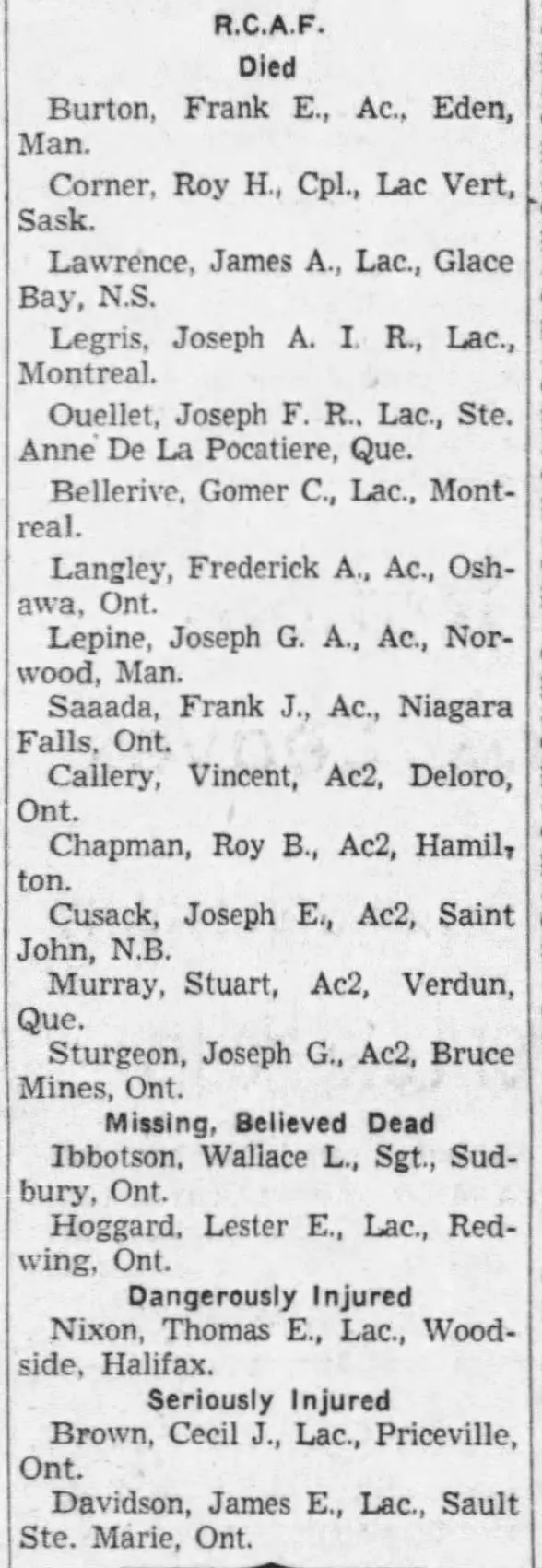
The Knights of Columbus Hostel fire was a structure fire that occurred on December 12, 1942, in St. John's, Newfoundland in a hostel operated by the Knights of Columbus, a Roman Catholic fraternal organization. A total of 99 people were killed, 80 of whom were military personnel. 109 others were critically wounded.
Taking place during World War II, the fire is believed by many to have been an incident of enemy sabotage orchestrated by agents of Nazi Germany.
The area was a centre of military personnel and activities, including soldiers, sailors, and air forces. Within a few weeks, other suspicious fires or their makings occurred in St. John's that winter, at sites frequented by military personnel. Wikipedia
Stirling
LJ 594
1944-09-18
Halifax B.Mk.III
LK 754
1944-02-24
Sunderland Mk. III
ML 743
1945-03-14
Ship
MV Amerika
1943-04-22
Sinking of the MV Amerika
The MV Amerika was torpedoed and sunk off Greenland by a German submarine. The Amerika was 10,000 tons with a crew of 87 and 53 RCAF Officers on board. They were positioned near the end of the convoy and a storm was raging when they were sunk 12 miles south-east of Cape Farewell, Greenland. 16 RCAF Officers were rescued by a Corvette - H.M.S. Asphodel after spending 4 hours in a damaged lifeboat. They were taken ashore at Greenock, Scotland. Of the 16 survivors only one, Flying Officer A. Allen, was killed during the war. He was lost while on operations with 90 Squadron.
Ship
MV Vancouver Island
1941-10-15
Sinking of the MV Vancouver Island
At 21.54 hours on 15 Oct 1941 the unescorted Vancouver Island (Master Eric Lacey Roper) was spotted by U-558, which was searching convoy SC-48 west of Ireland. Due to her high speed of about 15 knots the U-boat immediately went on full speed to get into a favorable attack position and fired a spread of three torpedoes from about 2000 meters at 22.49 hours, hitting the ship with two of them after 144 seconds. The vessel was hit in the fore part and amidships and stopped but did not sink. Because Krech wanted to continue the search for convoy he fired two coups de grace from more than 1000 meters at 23.08 and 23.17 hours, hitting the ship fore and aft and causing her to sink fast by the stern.
The Germans had observed how the crew abandoned ship in lifeboats after the first hits, but HMS Dianthus (K 95) (LtCdr C.E. Bridgman, RNR) sent to her assistance from the dispersed convoy ON-24 did not find any survivors. On 31 October, a lifeboat with the bodies of two officers from the ship was found by a British warship in 56°08N/20°45W. The master, 64 crew members, eight gunners and 32 passengers were lost.
Sunderland
N 9029
1943-01-01
Sunderland Mk. III
NJ 175
1944-08-12
Halifax B.Mk.VII
NP 710
1944-09-11
Ship
SS Caribou
1942-10-14
Sinking of the SS Caribou
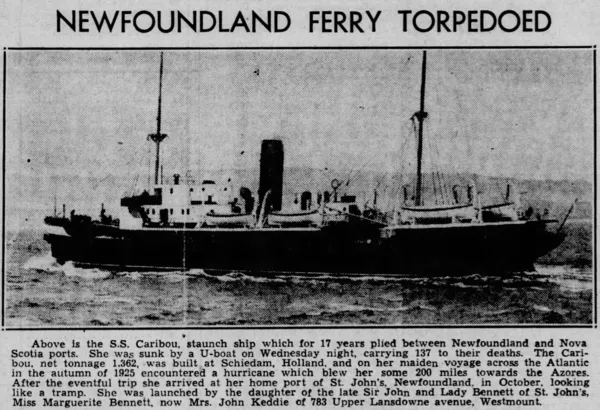
On the 14th October 1942, SS CARIBOU, on voyage from North Sydney, Nova Scotia, Canada to Port aux Basques, Newfoundland with passengers, was torpedoed and sunk by the German submarine U-69, 25 miles south of Port Aux Basques off Cabot Strait. 136 people died.
Story: CARIBOU (Capt. Taverner) was torpedoed by U-69 (Kapitanleutnant Ulrich Graf) while in convoy NL-9, on her regular run between Cape Breton and Newfoundland. Her escort, the minesweeper HMCS GRANDMERE had only short range asdic (sonar detection) and no radar. GRANDMERE did not detect the submarine but sighted it after the attack, giving chase with depth charges as the submarine dove.
U-69's torpedo struck at 2:21 am hitting CARIBOU's boilers. The explosion was very violent and the CARIBOU was ripped in two pieces. She sank in 5 minutes. Survivors were left in overcrowded lifeboats and clinging to wreckage until dawn when GRANDMERE returned from its unsuccessful hunt for U-69. Only 101 of the 237 people aboard survived. 31 crew, 57 military and 48 passengers died.
Part of the passengers on board were women and children, who were heading to Nova Scotia to welcome a contingent of RCN sailors home from overseas. The sinking caused alarm in the Canadian and Newfoundland public about the vulnerability of the St. Lawrence to submarine attack. reference: wrecksite.eu
Ship
SS Nerissa
1941-04-30
Sinking of the SS Nerissa
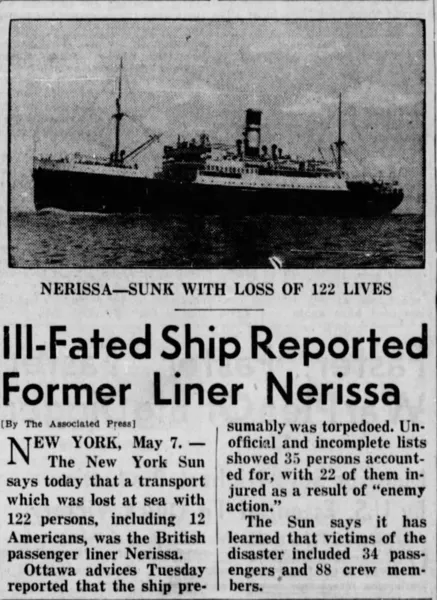
By April 1941, the troopship SS Nerissa had made a dozen wartime crossings of the North Atlantic. Her final crossing began on 21 April 1941 in Halifax. The Officer Commanding all embarked Canadian and Allied troops (OC Troops) was Lieutenant Colonel Kenneth Charles Burness, MC and Bar, PPCLI. Nerissa arrived in St. John's Newfoundland at about 6:00 AM local time on Wednesday 23 April. Early on the 24rd, she sailed independently from St. John's bound for Liverpool. A total of 291 persons were embarked:
- 105 Merchant Navy crew members
- 16 Royal Canadian Navy (4 officers and 12 Ordinary Telegraphists)
- 108 Canadian Army personnel from logistics, artillery, medical, infantry, armoured, signals, engineers and provost (RCMP) units
- 5 Royal Navy (Including 2 DEMS gunners for assisting the crew in manning the 4-inch Breech Loading MK VII naval gun)
- 12 Royal Air Force - A Wing Commander and staff of 11 were returning to the UK after serving as Officer Commanding Troops (O.C. Troops) in various troopships
- 7 British Army - An officer of the 11th Hussars and 6 Royal Artillery Maritime Regiment gunners for manning the Bofors 40-mm anti-aircraft gun
- 14 Air Transport Auxiliary (ATA) American pilots
- 4 Norwegian Army Air Service personnel who had completed training at the "Little Norway" base on Toronto Island, and were being transferred to air force headquarters in London
- 20 civilians
North Star C4-1
TCA 223
1954-04-08
Sunderland Mk.II
W 3982
1941-08-21
Sunderland Mk.II
W 3998
1941-12-21
Sunderland Mk. III
W 6031
1943-11-20
 Flying Officer
Flying Officer Squadron Leader
Squadron Leader Sergeant
Sergeant Civilian
Civilian Flight Lieutenant
Flight Lieutenant Flight Sergeant
Flight Sergeant Flight Sergeant
Flight Sergeant Second Lieutenant
Second Lieutenant